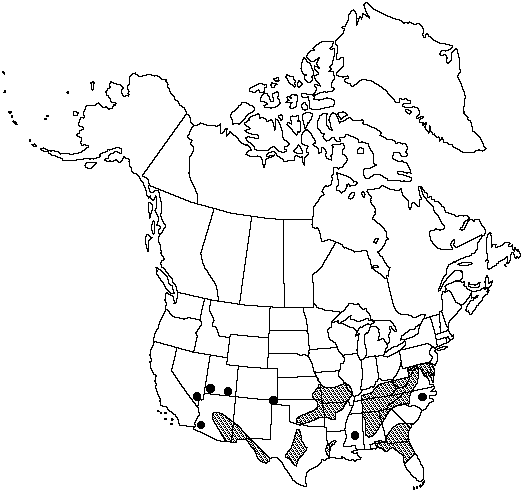Difference between revisions of "Asplenium resiliens"
Linnaea 18: 331. 1844.
FNA>Volume Importer |
imported>Volume Importer |
||
| (7 intermediate revisions by 2 users not shown) | |||
| Line 17: | Line 17: | ||
}}<!-- | }}<!-- | ||
| − | --><span class="statement" id="st- | + | --><span class="statement" id="st-undefined" data-properties=""><b>Roots </b>not proliferous. <b>Stems</b> erect, unbranched; scales black throughout, linear-lanceolate, 4–5 × 0.2–0.6 mm, margins entire. <b>Leaves</b> monomorphic. <b>Petiole</b> black throughout, lustrous, 1.5–3(–5) cm, 1/4–1/10 length of blade; indument of blackish brown, filiform scales. <b>Blade</b> linear to narrowly oblanceolate, 1-pinnate throughout, 9–20(–30) × 1–2(–2.5) cm, thick, glabrous; base gradually tapered; apex acute, not rooting. <b>Rachis</b> black throughout, lustrous, glabrous. <b>Pinnae</b> in 20–40 pairs, oblong; medial pinnae (5–)10–20 × (2–)3–5 mm; base usually with an acroscopic auricle; margins ± entire to shallowly crenate; apex obtuse. <b>Veins</b> free, obscure. <b>Sori</b> 2–5 pairs per pinna, on both basiscopic and acroscopic sides, often confluent with age. <b>Spores</b> 32 per sporangium. n = 2n = 108 (apogamous).</span><!-- |
-->{{Treatment/Body | -->{{Treatment/Body | ||
| Line 23: | Line 23: | ||
|elevation=100–1500 m | |elevation=100–1500 m | ||
|distribution=Ala.;Ariz.;Ark.;Del.;Fla.;Ga.;Ill.;Kans.;Ky.;La.;Md.;Miss.;Mo.;N.Mex.;Nev.;N.C.;Okla.;Pa.;Tenn.;Tex.;Utah;Va.;W.Va.;Mexico;West Indies in Hispaniola;Jamaica;Central America in Guatemala;South America. | |distribution=Ala.;Ariz.;Ark.;Del.;Fla.;Ga.;Ill.;Kans.;Ky.;La.;Md.;Miss.;Mo.;N.Mex.;Nev.;N.C.;Okla.;Pa.;Tenn.;Tex.;Utah;Va.;W.Va.;Mexico;West Indies in Hispaniola;Jamaica;Central America in Guatemala;South America. | ||
| − | |discussion=<p>Asplenium parvulum M. Martens & Galeotti is an older, but illegitimate, name because it is a later homonym of A. parvulum Hooker.</p><!-- | + | |discussion=<p><i>Asplenium</i> parvulum M. Martens & Galeotti is an older, but illegitimate, name because it is a later homonym of <i>A. parvulum</i> Hooker.</p><!-- |
| − | --><p>In Florida Asplenium resiliens hybridizes with A. heterochroum Kunze (4 x), producing A. × heteroresiliens (5 x).</p> | + | --><p>In Florida <i>Asplenium resiliens</i> hybridizes with <i>A. heterochroum</i> Kunze (4 x), producing <i>A.</i> × <i>heteroresiliens</i> (5 x).</p> |
|tables= | |tables= | ||
|references= | |references= | ||
| Line 33: | Line 33: | ||
-->{{#Taxon: | -->{{#Taxon: | ||
name=Asplenium resiliens | name=Asplenium resiliens | ||
| − | |||
|authority=Kunze | |authority=Kunze | ||
|rank=species | |rank=species | ||
| Line 47: | Line 46: | ||
|publication year=1844 | |publication year=1844 | ||
|special status= | |special status= | ||
| − | |source xml=https:// | + | |source xml=https://bitbucket.org/aafc-mbb/fna-data-curation/src/2e0870ddd59836b60bcf96646a41e87ea5a5943a/coarse_grained_fna_xml/V2/V2_468.xml |
|genus=Asplenium | |genus=Asplenium | ||
|species=Asplenium resiliens | |species=Asplenium resiliens | ||
| − | |||
| − | |||
| − | |||
| − | |||
| − | |||
| − | |||
| − | |||
| − | |||
| − | |||
| − | |||
| − | |||
| − | |||
| − | |||
| − | |||
| − | |||
| − | |||
| − | |||
| − | |||
| − | |||
| − | |||
| − | |||
| − | |||
| − | |||
| − | |||
| − | |||
| − | |||
| − | |||
| − | |||
| − | |||
| − | |||
| − | |||
| − | |||
| − | |||
| − | |||
| − | |||
| − | |||
| − | |||
| − | |||
| − | |||
| − | |||
| − | |||
| − | |||
}}<!-- | }}<!-- | ||
-->[[Category:Treatment]][[Category:Asplenium]] | -->[[Category:Treatment]][[Category:Asplenium]] | ||
Latest revision as of 21:23, 5 November 2020
Roots not proliferous. Stems erect, unbranched; scales black throughout, linear-lanceolate, 4–5 × 0.2–0.6 mm, margins entire. Leaves monomorphic. Petiole black throughout, lustrous, 1.5–3(–5) cm, 1/4–1/10 length of blade; indument of blackish brown, filiform scales. Blade linear to narrowly oblanceolate, 1-pinnate throughout, 9–20(–30) × 1–2(–2.5) cm, thick, glabrous; base gradually tapered; apex acute, not rooting. Rachis black throughout, lustrous, glabrous. Pinnae in 20–40 pairs, oblong; medial pinnae (5–)10–20 × (2–)3–5 mm; base usually with an acroscopic auricle; margins ± entire to shallowly crenate; apex obtuse. Veins free, obscure. Sori 2–5 pairs per pinna, on both basiscopic and acroscopic sides, often confluent with age. Spores 32 per sporangium. n = 2n = 108 (apogamous).
Habitat: Cliffs, sinkholes, on limestone or other basic rocks
Elevation: 100–1500 m
Distribution

Ala., Ariz., Ark., Del., Fla., Ga., Ill., Kans., Ky., La., Md., Miss., Mo., N.Mex., Nev., N.C., Okla., Pa., Tenn., Tex., Utah, Va., W.Va., Mexico, West Indies in Hispaniola, Jamaica, Central America in Guatemala, South America.
Discussion
Asplenium parvulum M. Martens & Galeotti is an older, but illegitimate, name because it is a later homonym of A. parvulum Hooker.
In Florida Asplenium resiliens hybridizes with A. heterochroum Kunze (4 x), producing A. × heteroresiliens (5 x).
Selected References
None.